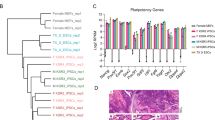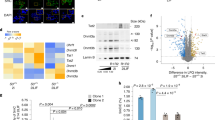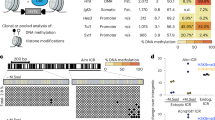Abstract
In recent years, solid evidence has accumulated that insulin-like growth factor-1 (IGF-1) and 2 (IGF-2) regulate many biological processes in normal and malignant cells. Recently, more light has been shed on the epigenetic mechanisms regulating expression of genes involved in IGF signaling (IFS) and it has become evident that these mechanisms are crucial for initiation of embryogenesis, maintaining the quiescence of pluripotent stem cells deposited in adult tissues (for example, very-small embryonic-like stem cells), the aging process, and the malignant transformation of cells. The expression of several genes involved in IFS is regulated at the epigenetic level by imprinting/methylation within differentially methylated regions (DMRs), which regulate their expression from paternal or maternal chromosomes. The most important role in the regulation of IFS gene expression is played by the Igf-2-H19 locus, which encodes the autocrine/paracrine mitogen IGF-2 and the H19 gene, which gives rise to a non-coding RNA precursor of several microRNAs that negatively affect cell proliferation. Among these, miR-675 has recently been demonstrated to downregulate expression of the IGF-1 receptor. The proper imprinting of DMRs at the Igf-2-H19 locus, with methylation of the paternal chromosome and a lack of methylation on the maternal chromosome, regulates expression of these genes so that Igf-2 is transcribed only from the paternal chromosome and H19 (including miR-675) only from the maternal chromosome. In this review, we will discuss the relevance of (i) proper somatic imprinting, (ii) erasure of imprinting and (iii) loss of imprinting within the DMRs at the Igf-2-H19 locus to the expression of genes involved in IFS, and the consequences of these alternative patterns of imprinting for stem cell biology.
This is a preview of subscription content, access via your institution
Access options
Subscribe to this journal
Receive 12 print issues and online access
$259.00 per year
only $21.58 per issue
Buy this article
- Purchase on Springer Link
- Instant access to full article PDF
Prices may be subject to local taxes which are calculated during checkout



Similar content being viewed by others
References
Reik W, Walter J . Genomic imprinting: parental influence on the genome. Nat Rev Genet 2001; 2: 21–32.
Delaval K, Feil R . Epigenetic regulation of mammalian genomic imprinting. Curr Opin Genet Dev 2004; 14: 188–195.
Kobayashi H, Suda C, Abe T, Kohara Y, Ikemura T, Sasaki H . Bisulfite sequencing and dinucleotide content analysis of 15 imprinted mouse differentially methylated regions (DMRs): paternally methylated DMRs contain less CpGs than maternally methylated DMRs. Cytogenet Genome Res 2006; 113: 130–137.
Ratajczak MZ, Shin DM, Liu R, Mierzejewska K, Ratajczak J, Kucia M et al. Very small embryonic/epiblast-like stem cells (VSELs) and their potential role in aging and organ rejuvenation--an update and comparison to other primitive small stem cells isolated from adult tissues. Aging (Albany, NY) 2012; 4: 235–246.
Keniry A, Oxley D, Monnier P, Kyba M, Dandolo L, Smits G et al. The H19 lincRNA is a developmental reservoir of miR-675 that suppresses growth and Igf1r. Nat Cell Biol 2012; 14: 659–665.
Ratajczak MZ, Shin DM, Ratajczak J, Kucia M, Bartke A . A novel insight into aging: are there pluripotent very small embryonic-like stem cells (VSELs) in adult tissues overtime depleted in an Igf-1-dependent manner? Aging (Albany, NY) 2010; 2: 875–883.
Ratajczak J, Shin DM, Wan W, Liu R, Masternak MM, Piotrowska K et al. Higher number of stem cells in the bone marrow of circulating low Igf-1 level Laron dwarf mice—novel view on Igf-1, stem cells and aging. Leukemia 2011; 25: 729–733.
Kucia M, Shin DM, Liu R, Ratajczak J, Bryndza E, Masternak MM et al. Reduced number of VSELs in the bone marrow of growth hormone transgenic mice indicates that chronically elevated Igf1 level accelerates age-dependent exhaustion of pluripotent stem cell pool: a novel view on aging. Leukemia 2011; 25: 1370–1374.
Kucia M, Masternak M, Liu R, Shin DM, Ratajczak J, Mierzejewska K et al. The negative effect of prolonged somatotrophic/insulin signaling on an adult bone marrow-residing population of pluripotent very small embryonic-like stem cells (VSELs). Age (Dordr) 2012; DOI: 10.1007/s11357-011-9364-8.
Feinberg AP . Phenotypic plasticity and the epigenetics of human disease. Nature 2007; 447: 433–440.
Thorvaldsen JL, Duran KL, Bartolomei MS . Deletion of the H19 differentially methylated domain results in loss of imprinted expression of H19 and Igf2. Genes Dev 1998; 12: 3693–3702.
Srivastava M, Hsieh S, Grinberg A, Williams-Simons L, Huang S-P, Pfeifer K . H19 and Igf2 monoallelic expression is regulated in two distinct ways by a shared cis acting regulatory region upstream of H19. Genes Dev 2000; 14: 1186–1195.
Schoenherr CJ, Levorse JM, Tilghman SM . CTCF maintains differential methylation at the Igf2/H19 locus. Nat Genet 2003; 33: 66–69.
Takai D, Gonzales FA, Tsai YC, Thayer MJ, Jones PA . Large scale mapping of methylcytosines in CTCF-binding sites in the human H19 promoter and aberrant hypomethylation in human bladder cancer. Hum Mol Genet 2001; 10: 2619–2626.
Jones BK, Levorse J, Tilghman SM . A human H19 transgene exhibits impaired paternal-specific imprint acquisition and maintenance in mice. Hum Mol Genet 2002; 11: 411–418.
Brooks AJ, Waters MJ . The growth hormone receptor: mechanism of activation and clinical implications. Nat Rev Endocrinol 2010; 6: 515–525.
Ludwig T, Eggenschwiler J, Fisher P, D’Ercole AJ, Davenport ML, Efstratiadis A . Mouse mutants lacking the type 2 IGF receptor (IGF2R) are rescued from perinatal lethality in Igf2 and Igf1r null backgrounds. Dev Biol 1996; 177: 517–535.
Cai X, Cullen BR . The imprinted H19 noncoding RNA is a primary microRNA precursor. RNA 2007; 13: 313–316.
Leighton PA, Ingram RS, Eggenschwiler J, Efstratiadis A, Tilghman SM . Disruption of imprinting caused by deletion of the H19 gene region in mice. Nature 1995; 375: 34–39.
Verona RI, Bartolomei MS . Role of H19 3′ sequences in controlling H19 and Igf2 imprinting and expression. Genomics 2004; 84: 59–68.
Tran VG, Court F, Duputié A, Antoine E, Aptel N, Milligan L et al. H19 antisense RNA can up-regulate Igf2 transcription by activation of a novel promoter in mouse myoblasts. PLoS ONE 2012; 7: e37923.
Kono T, Obata Y, Wu Q, Niwa K, Ono Y, Yamamoto Y et al. Birth of parthenogenetic mice that can develop to adulthood. Nature 2004; 428: 860–864.
Surani MA, Hayashi K, Hajkova P . Genetic and epigenetic regulators of pluripotency. Cell 2007; 128: 747–762.
Shin DM, Zuba-Surma EK, Wu W, Ratajczak J, Wysoczynski M, Ratajczak MZ et al. Novel epigenetic mechanisms that control pluripotency and quiescence of adult bone marrow-derived Oct4+ very small embryonic-like stem cells. Leukemia 2009; 23: 2042–2051.
Shin DM, Liu R, Klich I, Wu W, Ratajczak J, Kucia M et al. Molecular signature of adult bone marrow-purified very small embryonic-like stem cells supports their developmental epiblast/germ line origin. Leukemia 2010; 24: 1450–1461.
Kucia M, Reca R, Campbell FR, Zuba-Surma E, Majka M, Ratajczak J et al. A population of very small embryonic-like (VSEL) CXCR4+SSEA-1+Oct-4+ stem cells identified in adult bone marrow. Leukemia 2006; 20: 857–869.
Kucia M, Wysoczynski M, Ratajczak J, Ratajczak M . Identification of very small embryonic like (VSEL) stem cells in bone marrow. Cell Tissue Res 2008; 331: 125–134.
Zuba-Surma EK, Kucia M, Wu W, Klich I, JWL Ratajczak J et al. Very small embryonic-like stem cells are present in adult murine organs: ImageStream-based morphological analysis and distribution studies. Cytometry Part A 2008; 73A: 1116–1127.
Ratajczak MZ, Machalinski B, Wojakowski W, Ratajczak J, Kucia M . A hypothesis for an embryonic origin of pluripotent Oct-4+ stem cells in adult bone marrow and other tissues. Leukemia 2007; 21: 860–867.
Hayashi K, de Sousa Lopes SMC, Surani MA . Germ cell specification in mice. Science 2007; 316: 394–396.
Shamblott MJ, Axelman J, Wang S, Bugg EM, Littlefield JW, Donovan PJ et al. Derivation of pluripotent stem cells from cultured human primordial germ cells. Proc Natl Acad Sci USA 1998; 95: 13726–13731.
Matsui Y, Zsebo K, Hogan BLM . Derivation of pluripotential embryonic stem cells from murine primordial germ cells in culture. Cell 1992; 70: 841–847.
Wylie C . Germ cells. Cell 1999; 96: 165–174.
Kucia M, Halasa M, Wysoczynski M, Baskiewicz-Masiuk M, Moldenhawer S, Zuba-Surma E et al. Morphological and molecular characterization of novel population of CXCR4+ SSEA-4+ Oct-4+ very small embryonic-like cells purified from human cord blood - preliminary report. Leukemia 2006; 21: 297–303.
Wojakowski W, Tendera M, Kucia M, Zuba-Surma E, Paczkowska E, Ciosek J et al. Mobilization of bone marrow-derived Oct-4+ SSEA-4+ very small embryonic-like stem cells in patients with acute myocardial infarction. J Am Coll Cardiol 2009; 53: 1–9.
Paczkowska E, Kucia M, Koziarska D, Halasa M, Safranow K, Masiuk M et al. Clinical evidence that very small embryonic-like stem cells are mobilized into peripheral blood in patients after stroke. Stroke 2009; 40: 1237–1244.
Ratajczak MZ, Liu R, Ratajczak J, Kucia M, Shin D-M . The role of pluripotent embryonic-like stem cells residing in adult tissues in regeneration and longevity. Differentiation 2011; 81: 153–161.
Morison IM, Ramsay JP, Spencer HG . A census of mammalian imprinting. Trends Genet 2005; 21: 457–465.
Shin DM, Liu R, Wu W, Waigel SJ, Zacharias W, Ratajczak MZ et al. Global gene expression analysis of very small embryonic-like stem cells reveals that the Ezh2-dependent bivalent domain mechanism contributes to their pluripotent state. Stem Cells Dev 2012; 21: 1639–1652.
Ragina NP, Schlosser K, Knott JG, Senagore PK, Swiatek PJ, Chang EA et al. Downregulation of H19 improves the differentiation potential of mouse parthenogenetic embryonic stem cells. Stem Cells Dev 2012; 21: 1134–1144.
Ratajczak MZ, Shin D-M, Kucia M . Very small embryonic/epiblast-like stem cells: a missing link to support the germ line hypothesis of cancer development? Am J Pathol 2009; 174: 1985–1992.
Pedone PV, Tirabosco R, Cavazzana AO, Ungaro P, Basso G, Luksch R et al. Mono- and bi-allelic expression of insulin-like growth factor II gene in human muscle tumors. Hum Mol Genet 1994; 3: 1117–1121.
Zhan S, Shapiro DN, Helman LJ . Activation of an imprinted allele of the insulin-like growth factor II gene implicated in rhabdomyosarcoma. J Clin Invest 1994; 94: 445–448.
Piper MDW, Bartke A . Diet and Aging. Cell Metab 2008; 8: 99–104.
Bartke A . Insulin and aging. Cell Cycle 2008; 7: 3338–3343.
Avogaro A, de Kreutzenberg SV, Fadini GP . Insulin signaling and life span. Pflugers Arch 2010; 459: 301–314.
Russell SJ, Kahn CR . Endocrine regulation of ageing. Nat Rev Mol Cell Biol 2007; 8: 681–691.
Bartke A, Brown-Borg H . Life extension in the dwarf mouse. In: Gerald PS (ed). Current Topics in Developmental Biology, vol. 63. Academic Press, 2004; pp 189–225.
Ratajczak J, Wysoczynski M, Zuba-Surma E, Wan W, Kucia M, Yoder MC et al. Adult murine bone marrow-derived very small embryonic-like stem cells differentiate into the hematopoietic lineage after coculture over OP9 stromal cells. Exp Hematol 2011; 39: 225–237.
Ratajczak J, Zuba-Surma E, Klich I, Liu R, Wysoczynski M, Greco N et al. Hematopoietic differentiation of umbilical cord blood-derived very small embryonic/epiblast-like stem cells. Leukemia 2011; 25: 1278–1285.
Ratajczak MZ, Zuba-Surma EK, Shin D-M, Ratajczak J, Kucia M . Very small embryonic-like (VSEL) stem cells in adult organs and their potential role in rejuvenation of tissues and longevity. Exp Gerontol 2008; 43: 1009–1017.
Shin DM, Kucia M, Ratajczak MZ . Nuclear and chromatin reorganization during cell senescence and aging – a mini-review. Gerontology 2011; 57: 76–84.
Leontieva OV, Blagosklonny MV . Yeast-like chronological senescence in mammalian cells: phenomenon, mechanism and pharmacological suppression. Aging (Albany NY) 2011; 3: 1078–1091.
Gallagher EJ, LeRoith D . The proliferating role of insulin and insulin-like growth factors in cancer. Trend Endocrinol Metab 2010; 21: 610–618.
Leslie M . Growth defect blocks cancer and diabetes. Science 2011; 331: 837.
Guevara-Aguirre J, Balasubramanian P, Guevara-Aguirre M, Wei M, Madia F, Cheng CW et al. Growth hormone receptor deficiency is associated with a major reduction in pro-aging signaling, cancer, and diabetes in humans. Sci Transl Med 2011; 3: 70ra13.
Ratajczak MZ, Shin DM, Liu R, Marlicz W, Tarnowski M, Ratajczak J et al. Epiblast/germ line hypothesis of cancer development revisited: lesson from the presence of Oct-4+ cells in adult tissues. Stem Cell Rev 2010; 6: 307–316.
Fu VX, Schwarze SR, Kenowski ML, LeBlanc S, Svaren J, Jarrard DF . A Loss of insulin-like growth factor-2 imprinting is modulated by CCCTC-binding factor down-regulation at senescence in human epithelial cells. J Biol Chem 2004; 279: 52218–52226.
Doepfner KT, Spertini O, Arcaro A . Autocrine insulin-like growth factor-I signaling promotes growth and survival of human acute myeloid leukemia cells via the phosphoinositide 3-kinase//Akt pathway. Leukemia 2007; 21: 1921–1930.
Tazzari PL, Tabellini G, Bortul R, Papa V, Evangelisti C, Grafone T et al. The insulin-like growth factor-I receptor kinase inhibitor NVP-AEW541 induces apoptosis in acute myeloid leukemia cells exhibiting autocrine insulin-like growth factor-I secretion. Leukemia 2007; 21: 886–896.
Tamburini J, Chapuis N, Bardet V, Park S, Sujobert P, Willems L et al. Mammalian target of rapamycin (mTOR) inhibition activates phosphatidylinositol 3-kinase/Akt by up-regulating insulin-like growth factor-1 receptor signaling in acute myeloid leukemia: rationale for therapeutic inhibition of both pathways. Blood 2008; 111: 379–382.
Wu H-K, Weksberg R, Minden MD, Squire JA . Loss of imprinting of human insulin-like growth factor II gene, IGF2, in acute myeloid leukemia. Biochem Biophys Res Commun 1997; 231: 466–472.
Garrett RW, Emerson SG . The role of parathyroid hormone and insulin-like growth factors in hematopoietic niches: physiology and pharmacology. Mol Cell Endocrinol 2008; 288: 6–10.
Zumkeller W, Burdach S . The insulin-like growth factor system in normal and malignant hematopoietic cells. Blood 1999; 94: 3653–3657.
Movérare-Skrtic S, Svensson J, Karlsson MK, Orwoll E, Ljunggren O, Mellström D et al. Serum insulin-like growth factor-I concentration is associated with leukocyte telomere length in a population-based cohort of elderly men. J Clin Endocrinol Metab 2009; 94: 5078–5084.
Barbieri M, Paolisso G, Kimura M, Gardner JP, Boccardi V, Papa M et al. Higher circulating levels of IGF-1 are associated with longer leukocyte telomere length in healthy subjects. Mech Ageing Dev 2009; 130: 771–776.
Acknowledgements
This work was supported by NIH grant 2R01 DK074720, the Stella and Henry Endowment and Maestro 2011/02/A/NZ4/00035 grant to MZR.
Author information
Authors and Affiliations
Corresponding author
Ethics declarations
Competing interests
The authors declare no conflict of interest.
Rights and permissions
About this article
Cite this article
Ratajczak, M., Shin, DM., Schneider, G. et al. Parental imprinting regulates insulin-like growth factor signaling: a Rosetta Stone for understanding the biology of pluripotent stem cells, aging and cancerogenesis. Leukemia 27, 773–779 (2013). https://doi.org/10.1038/leu.2012.322
Received:
Revised:
Accepted:
Published:
Issue Date:
DOI: https://doi.org/10.1038/leu.2012.322
Keywords
This article is cited by
-
Initiation of Cancer: The Journey From Mutations in Somatic Cells to Epigenetic Changes in Tissue-resident VSELs
Stem Cell Reviews and Reports (2024)
-
Preventing/Reversing Adverse Effects of Endocrine Disruption on Mouse Testes by Normalizing Tissue Resident VSELs
Stem Cell Reviews and Reports (2023)
-
Proteomic Analysis of Murine Bone Marrow Very Small Embryonic-like Stem Cells at Steady-State Conditions and after In Vivo Stimulation by Nicotinamide and Follicle-Stimulating Factor Reflects their Germ-Lineage Origin and Multi Germ Layer Differentiation Potential
Stem Cell Reviews and Reports (2023)
-
Prolonged Growth Hormone/Insulin/Insulin-like Growth Factor Nutrient Response Signaling Pathway as a Silent Killer of Stem Cells and a Culprit in Aging
Stem Cell Reviews and Reports (2017)
-
A novel view of the adult bone marrow stem cell hierarchy and stem cell trafficking
Leukemia (2015)



